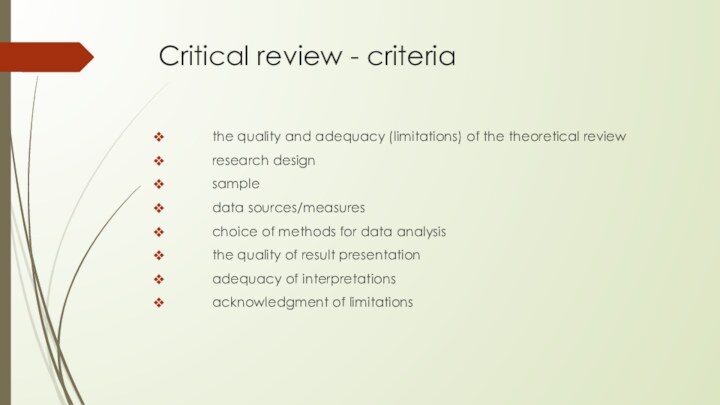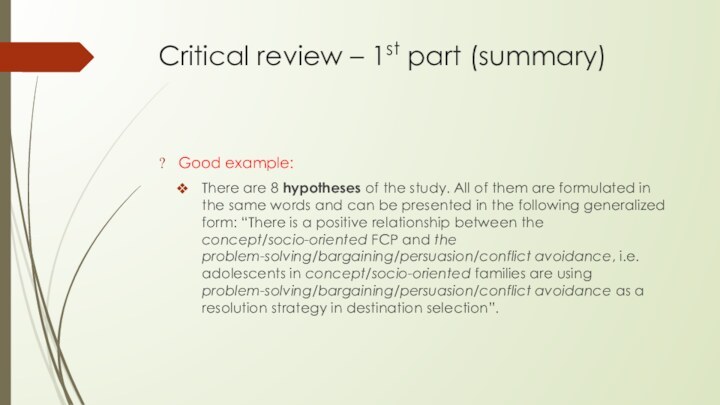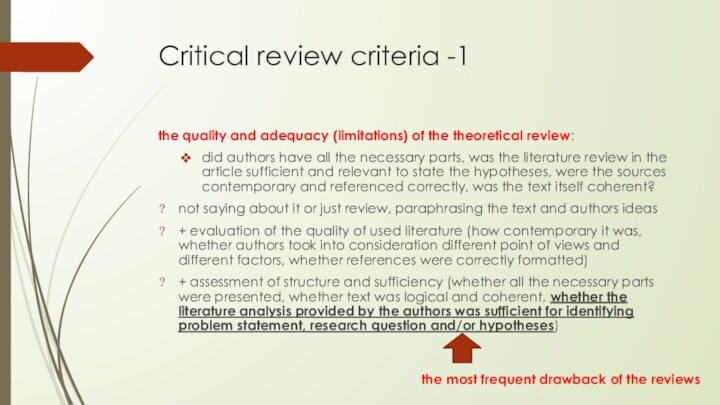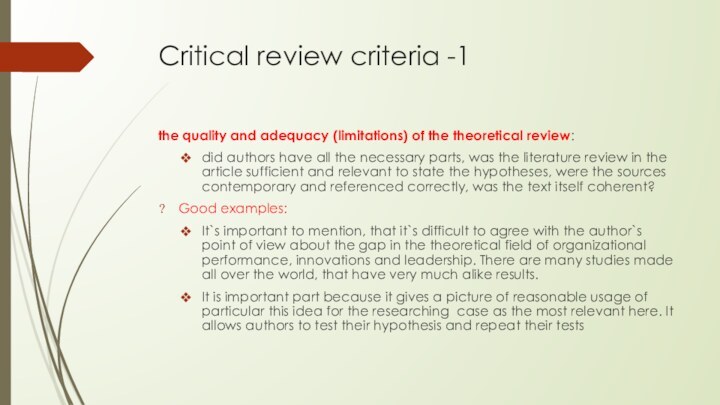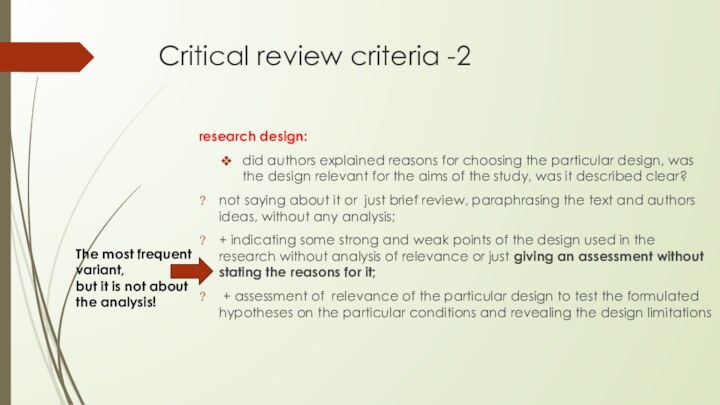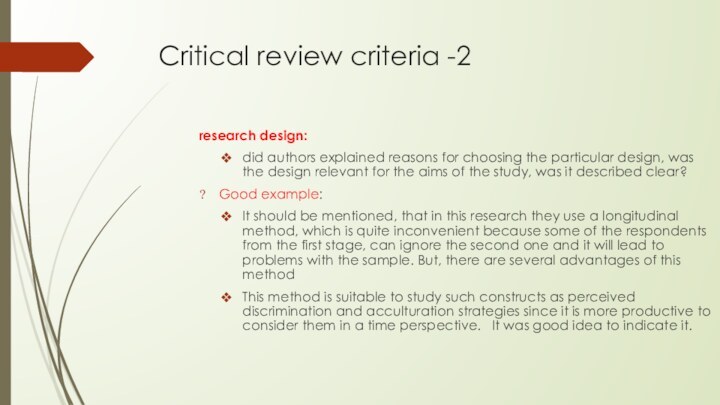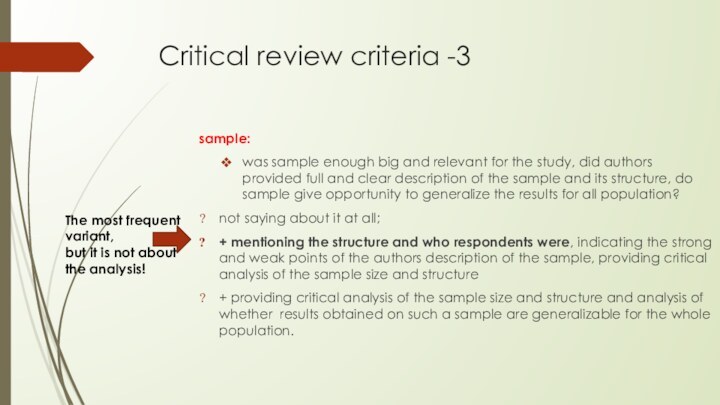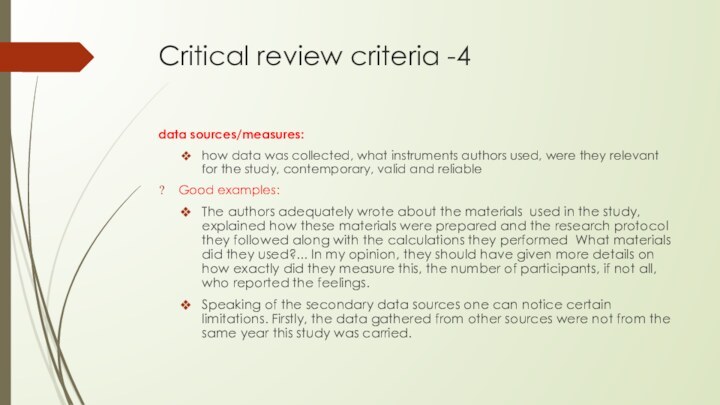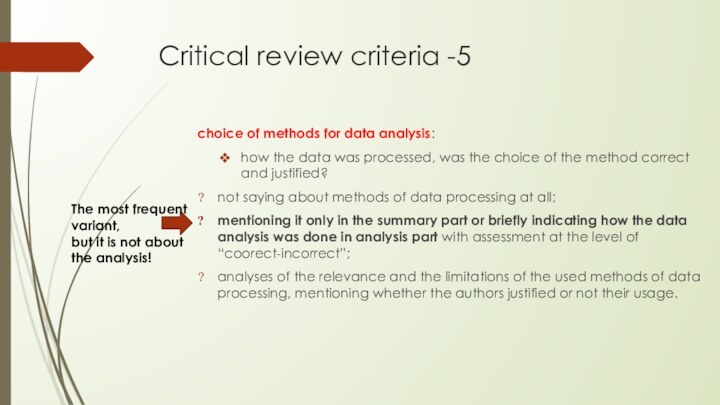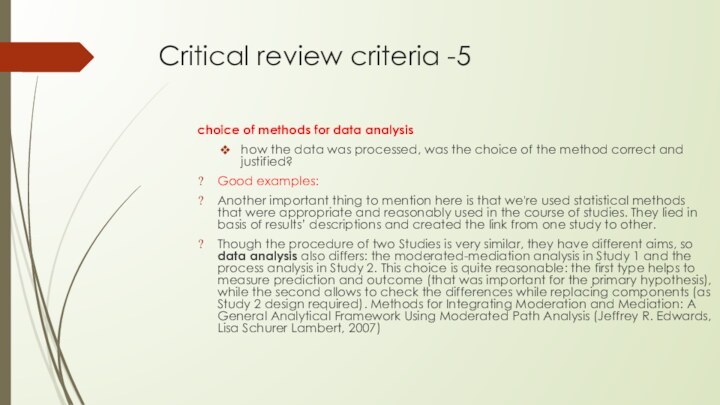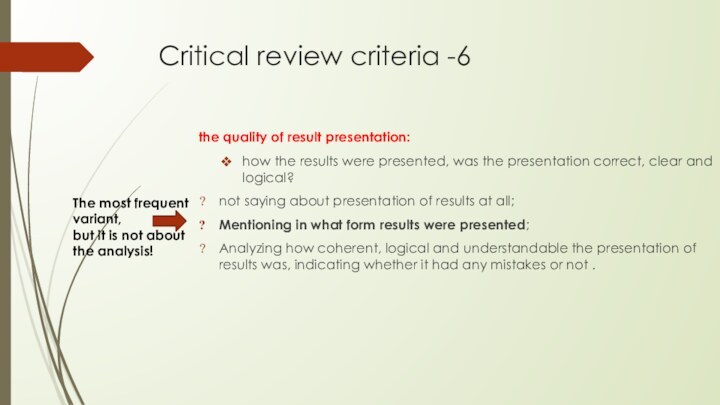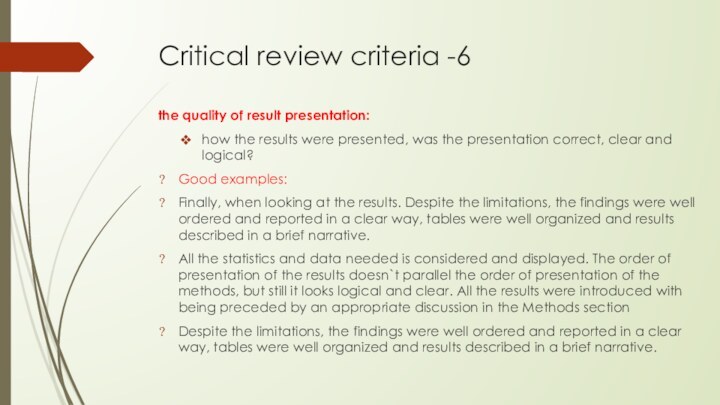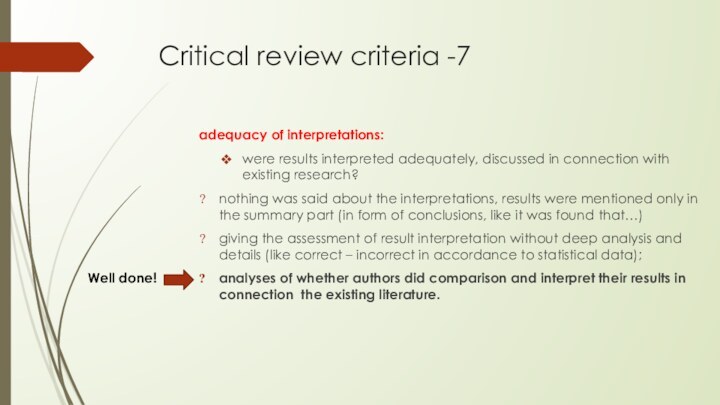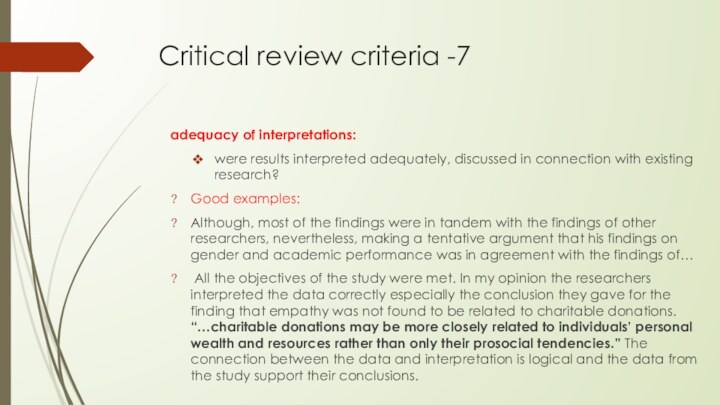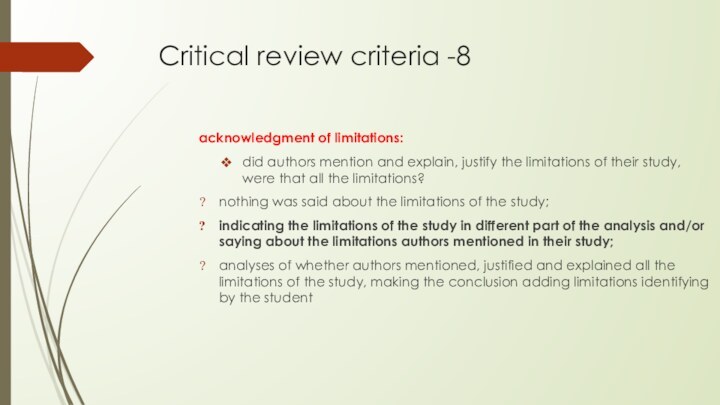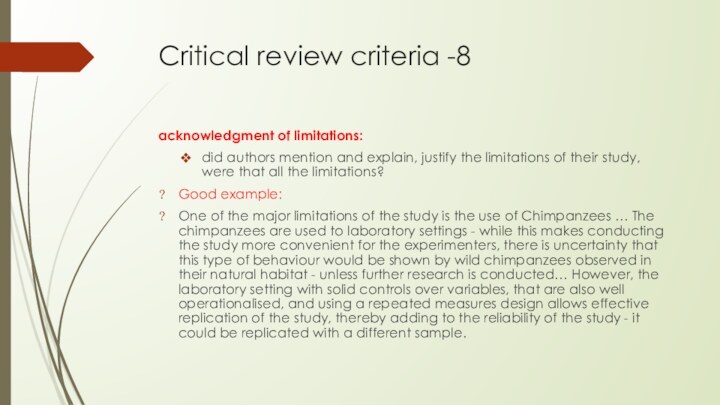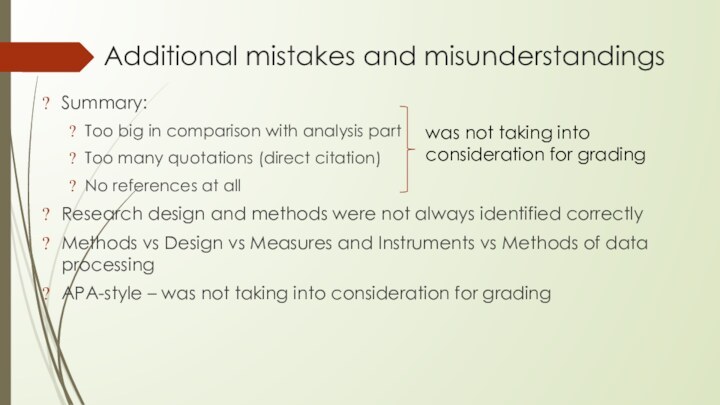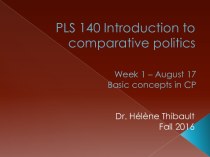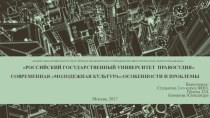Слайд 2
Critical review - criteria
the quality and adequacy (limitations)
of the theoretical review
research design
sample
data sources/measures
choice of methods
for data analysis
the quality of result presentation
adequacy of interpretations
acknowledgment of limitations
Слайд 3
Critical review – 1st part (summary)
Good example:
There are
8 hypotheses of the study. All of them are
formulated in the same words and can be presented in the following generalized form: “There is a positive relationship between the concept/socio-oriented FCP and the problem-solving/bargaining/persuasion/conflict avoidance, i.e. adolescents in concept/socio-oriented families are using problem-solving/bargaining/persuasion/conflict avoidance as a resolution strategy in destination selection”.
Слайд 4
Critical review criteria -1
the quality and adequacy (limitations)
of the theoretical review:
did authors have all the
necessary parts, was the literature review in the article sufficient and relevant to state the hypotheses, were the sources contemporary and referenced correctly, was the text itself coherent?
not saying about it or just review, paraphrasing the text and authors ideas
+ evaluation of the quality of used literature (how contemporary it was, whether authors took into consideration different point of views and different factors, whether references were correctly formatted)
+ assessment of structure and sufficiency (whether all the necessary parts were presented, whether text was logical and coherent, whether the literature analysis provided by the authors was sufficient for identifying problem statement, research question and/or hypotheses)
the most frequent drawback of the reviews
Слайд 5
Critical review criteria -1
the quality and adequacy (limitations)
of the theoretical review:
did authors have all the
necessary parts, was the literature review in the article sufficient and relevant to state the hypotheses, were the sources contemporary and referenced correctly, was the text itself coherent?
Good examples:
It`s important to mention, that it`s difficult to agree with the author`s point of view about the gap in the theoretical field of organizational performance, innovations and leadership. There are many studies made all over the world, that have very much alike results.
It is important part because it gives a picture of reasonable usage of particular this idea for the researching case as the most relevant here. It allows authors to test their hypothesis and repeat their tests
Слайд 6
Critical review criteria -2
research design:
did authors explained
reasons for choosing the particular design, was the design
relevant for the aims of the study, was it described clear?
not saying about it or just brief review, paraphrasing the text and authors ideas, without any analysis;
+ indicating some strong and weak points of the design used in the research without analysis of relevance or just giving an assessment without stating the reasons for it;
+ assessment of relevance of the particular design to test the formulated hypotheses on the particular conditions and revealing the design limitations
The most frequent
variant,
but it is not about
the analysis!
Слайд 7
Critical review criteria -2
research design:
did authors explained
reasons for choosing the particular design, was the design
relevant for the aims of the study, was it described clear?
Good example:
It should be mentioned, that in this research they use a longitudinal method, which is quite inconvenient because some of the respondents from the first stage, can ignore the second one and it will lead to problems with the sample. But, there are several advantages of this method
This method is suitable to study such constructs as perceived discrimination and acculturation strategies since it is more productive to consider them in a time perspective. It was good idea to indicate it.
Слайд 8
Critical review criteria -3
sample:
was sample enough big
and relevant for the study, did authors provided full
and clear description of the sample and its structure, do sample give opportunity to generalize the results for all population?
not saying about it at all;
+ mentioning the structure and who respondents were, indicating the strong and weak points of the authors description of the sample, providing critical analysis of the sample size and structure
+ providing critical analysis of the sample size and structure and analysis of whether results obtained on such a sample are generalizable for the whole population.
The most frequent
variant,
but it is not about
the analysis!
Слайд 9
Critical review criteria -3
sample:
was sample enough big
and relevant for the study, did authors provided full
and clear description of the sample and its structure, do sample give opportunity to generalize the results for all population?
Good examples:
Population was not specified and using only 190 students in Nigeria to make a generalization may lead to weak generalization. Population side should have been specified and clearly state the rationale behind the sample sizes
In this research, the sample is presented by the international students from different countries, who move to the United Kingdom for studying. It is very important aspect of the research because it provides some limitations. …
This method is suitable to study such constructs as perceived discrimination and acculturation strategies since it is more productive to consider them in a time perspective. It was good idea to indicate it.
Слайд 10
Critical review criteria -4
data sources/measures:
how data was
collected, what instruments authors used, were they relevant for
the study, contemporary, valid and reliable
not saying about it at all;
indicating how sampling was done and what materials were used, giving their brief assessment without stating the reasons for it;
+ assessment of relevance of the sampling methods and used materials, their strong points and limitations
The most frequent
variant,
but it is not about
the analysis!
Слайд 11
Critical review criteria -4
data sources/measures:
how data was
collected, what instruments authors used, were they relevant for
the study, contemporary, valid and reliable
Good examples:
The authors adequately wrote about the materials used in the study, explained how these materials were prepared and the research protocol they followed along with the calculations they performed What materials did they used?... In my opinion, they should have given more details on how exactly did they measure this, the number of participants, if not all, who reported the feelings.
Speaking of the secondary data sources one can notice certain limitations. Firstly, the data gathered from other sources were not from the same year this study was carried.
Слайд 12
Critical review criteria -5
choice of methods for data
analysis:
how the data was processed, was the choice
of the method correct and justified?
not saying about methods of data processing at all;
mentioning it only in the summary part or briefly indicating how the data analysis was done in analysis part with assessment at the level of “coorect-incorrect”;
analyses of the relevance and the limitations of the used methods of data processing, mentioning whether the authors justified or not their usage.
The most frequent
variant,
but it is not about
the analysis!
Слайд 13
Critical review criteria -5
choice of methods for data
analysis
how the data was processed, was the choice
of the method correct and justified?
Good examples:
Another important thing to mention here is that we're used statistical methods that were appropriate and reasonably used in the course of studies. They lied in basis of results’ descriptions and created the link from one study to other.
Though the procedure of two Studies is very similar, they have different aims, so data analysis also differs: the moderated-mediation analysis in Study 1 and the process analysis in Study 2. This choice is quite reasonable: the first type helps to measure prediction and outcome (that was important for the primary hypothesis), while the second allows to check the differences while replacing components (as Study 2 design required). Methods for Integrating Moderation and Mediation: A General Analytical Framework Using Moderated Path Analysis (Jeffrey R. Edwards, Lisa Schurer Lambert, 2007)
Слайд 14
Critical review criteria -6
the quality of result presentation:
how the results were presented, was the presentation correct,
clear and logical?
not saying about presentation of results at all;
Mentioning in what form results were presented;
Analyzing how coherent, logical and understandable the presentation of results was, indicating whether it had any mistakes or not .
The most frequent
variant,
but it is not about
the analysis!
Слайд 15
Critical review criteria -6
the quality of result presentation:
how the results were presented, was the presentation correct,
clear and logical?
Good examples:
Finally, when looking at the results. Despite the limitations, the findings were well ordered and reported in a clear way, tables were well organized and results described in a brief narrative.
All the statistics and data needed is considered and displayed. The order of presentation of the results doesn`t parallel the order of presentation of the methods, but still it looks logical and clear. All the results were introduced with being preceded by an appropriate discussion in the Methods section
Despite the limitations, the findings were well ordered and reported in a clear way, tables were well organized and results described in a brief narrative.
Слайд 16
Critical review criteria -7
adequacy of interpretations:
were results
interpreted adequately, discussed in connection with existing research?
nothing was
said about the interpretations, results were mentioned only in the summary part (in form of conclusions, like it was found that…)
giving the assessment of result interpretation without deep analysis and details (like correct – incorrect in accordance to statistical data);
analyses of whether authors did comparison and interpret their results in connection the existing literature.
Well done!
Слайд 17
Critical review criteria -7
adequacy of interpretations:
were results
interpreted adequately, discussed in connection with existing research?
Good examples:
Although,
most of the findings were in tandem with the findings of other researchers, nevertheless, making a tentative argument that his findings on gender and academic performance was in agreement with the findings of…
All the objectives of the study were met. In my opinion the researchers interpreted the data correctly especially the conclusion they gave for the finding that empathy was not found to be related to charitable donations. “…charitable donations may be more closely related to individuals’ personal wealth and resources rather than only their prosocial tendencies.” The connection between the data and interpretation is logical and the data from the study support their conclusions.
Слайд 18
Critical review criteria -8
acknowledgment of limitations:
did authors mention
and explain, justify the limitations of their study, were
that all the limitations?
nothing was said about the limitations of the study;
indicating the limitations of the study in different part of the analysis and/or saying about the limitations authors mentioned in their study;
analyses of whether authors mentioned, justified and explained all the limitations of the study, making the conclusion adding limitations identifying by the student
Слайд 19
Critical review criteria -8
acknowledgment of limitations:
did authors mention
and explain, justify the limitations of their study, were
that all the limitations?
Good example:
One of the major limitations of the study is the use of Chimpanzees … The chimpanzees are used to laboratory settings - while this makes conducting the study more convenient for the experimenters, there is uncertainty that this type of behaviour would be shown by wild chimpanzees observed in their natural habitat - unless further research is conducted… However, the laboratory setting with solid controls over variables, that are also well operationalised, and using a repeated measures design allows effective replication of the study, thereby adding to the reliability of the study - it could be replicated with a different sample.

